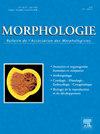在繁殖季节,淋巴细胞在丛林乌鸦的尾腺中聚集成椭圆形簇。
Q3 Medicine
引用次数: 0
摘要
背景:最近的研究表明,尿丘腺产生种内化学感觉线索。丛林乌鸦Corvus macrorhynchos是雀形目动物的一种,在繁殖季节,它的性腺表现出极端的形态变化。由于丛林乌鸦的尾尿腺在繁殖季节有时会出现形态变化,我们试图根据发育和季节来阐明丛林乌鸦尾尿腺的形态变化。方法:将捕获的鸟类按上腭颜色分为3个年龄组:2岁;用苏木精和伊红、Elastica van Gieson、Giemsa和增殖细胞核抗原抗体对尿尿腺石蜡切片进行染色。结果:丛林鸦尾尿腺形态未见性别二态性。然而,由于生长和季节的变化是确定的。在繁殖季节,2岁左右的鸟类,淋巴细胞在腺腔周围形成椭圆形簇状。这些团簇被球形细胞的胶原纤维侵入。结论:从球形细胞发育而来的胶原纤维似乎与淋巴细胞簇迁移有关。在繁殖季节,椭圆形淋巴细胞群可能在繁殖行为中起着至关重要的作用。本文章由计算机程序翻译,如有差异,请以英文原文为准。
During the breeding season, lymphocytes assemble into ellipse-shaped clusters in the uropygial gland of the jungle crow Corvus macrorhynchos
Background
Recent studies indicate that the uropygial gland produces intraspecific chemosensory cues. The jungle crow Corvus macrorhynchos, which is a type of passerine, exhibits extreme morphological variation in the gonadal gland during the breeding season. Because the uropygial gland of the jungle crow sometimes exhibits morphological changes during the breeding season, we attempted to clarify the morphological changes in the uropygial gland of the jungle crow according to development and season.
Methods
Captured birds were divided into three age groups according to the color of their upper palate: < 1 year, 1–2 years, and >2 years old. Paraffin sections of the uropygial gland were stained with hematoxylin and eosin, Elastica van Gieson, Giemsa, and a proliferating cell nuclear antigen antibody.
Results
Sexual dimorphism was not seen in the morphology of the uropygial gland in the jungle crow. However, changes due to growth and season were identified. During the breeding season in birds > 2 years old, lymphocytes formed ellipse-shaped clusters around the glandular cavity. These clusters were invaded by collagen fibers from spherical cells.
Conclusions
Collagen fibers, which develop from spherical cells, seem to be related to lymphoid cluster migration. Ellipse-shaped lymphoid clusters may play a crucial role in reproductive behavior during the breeding season.
求助全文
通过发布文献求助,成功后即可免费获取论文全文。
去求助
来源期刊

Morphologie
Medicine-Anatomy
CiteScore
2.30
自引率
0.00%
发文量
150
审稿时长
25 days
期刊介绍:
Morphologie est une revue universitaire avec une ouverture médicale qui sa adresse aux enseignants, aux étudiants, aux chercheurs et aux cliniciens en anatomie et en morphologie. Vous y trouverez les développements les plus actuels de votre spécialité, en France comme a international. Le objectif de Morphologie est d?offrir des lectures privilégiées sous forme de revues générales, d?articles originaux, de mises au point didactiques et de revues de la littérature, qui permettront notamment aux enseignants de optimiser leurs cours et aux spécialistes d?enrichir leurs connaissances.
 求助内容:
求助内容: 应助结果提醒方式:
应助结果提醒方式:


